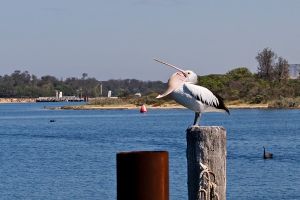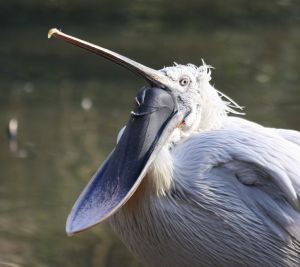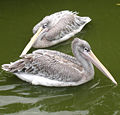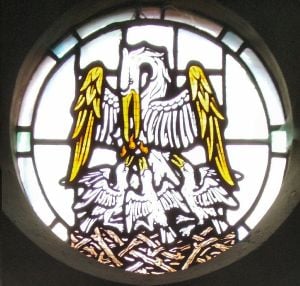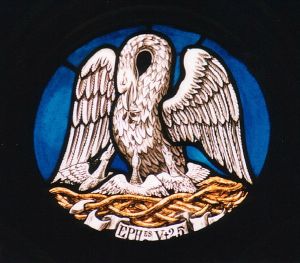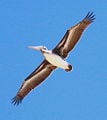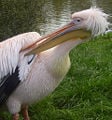Difference between revisions of "Pelican" - New World Encyclopedia
Rick Swarts (talk | contribs) |
Rick Swarts (talk | contribs) |
||
| Line 24: | Line 24: | ||
*''[[Pelecanus conspicillatus]]'' | *''[[Pelecanus conspicillatus]]'' | ||
}} | }} | ||
| + | '''Pelican''' is the common name for any of the large aquatic [[bird]]s comprising the [[genus]] '''''Pelecanus''''' of the family '''Pelecanidae''', characterized by heavy bodies, long necks, webbed feet in which all four toes are joined by web, and a long straight bill with a distinctive distenable, featherless pouch used for catching and holding [[fish]] prey. There are about eight extant species of pelicans. | ||
| − | + | Modern pelicans are found on all continents except [[Antarctica]]. They occur mostly in warm regions, though breeding ranges reach 45° south ([[Australian pelican]], ''P. conspicillatus'') and 60° North ([[American white pelican]]s, ''P. erythrorhynchos'', in western [[Canada]]) (Nelson et al. 2003). Birds of inland and coastal waters, they are absent from polar regions, the deep ocean, oceanic islands, and inland [[South America]]. | |
| − | |||
| − | == | + | ==Overview and description== |
| + | Along with the [[darter]]s, [[cormorant]]s, [[gannet]]s, [[booby|boobie]]s, [[frigatebird]]s, and [[tropicbird]]s, pelicans make up the [[order (biology)|order]] Pelecaniformes. Members of Pelecaniformes are medium to large aquatic birds with feet in which all four toes are joined by a web (totipalmate) (Howard 2003). The young are born atricial, meaning they have closed eyes and are helpless, requiring they be cared for by an adult. With the exceptio nof the tropicbirds, all lack natal down (Howard 2003). In most pelecaniform birds, there is a distensible gular sac located on the lower mandible, which in pelicans is bare and pendulous (handing down loosely), while in tropicbirds is feathered and in frigatebirds is bar, red, and inflatable (Howard 2003). | ||
| + | |||
| + | Pelicans comprise the ''Pelecanus'' genus. Typically, this is considered the only genus within the Pelecanidae family (pelican family) (Myers et al. 2008). However, some taxonomies include the genus ''Balaeniceps'' with its sole extant species, the shoebill (''Balaeniceps rex'') within Pelecanidae (ITIS 1998b). Mayr (2003) also found phylogenetic similarities between the shoebill and the pelicans. | ||
| + | |||
[[Image:Strange pelican behaviour.jpg|thumb|left|An Australian Pelican seemingly forcing its beak inside out, [[Lakes Entrance, Victoria]]]] | [[Image:Strange pelican behaviour.jpg|thumb|left|An Australian Pelican seemingly forcing its beak inside out, [[Lakes Entrance, Victoria]]]] | ||
Pelicans are large birds with enormous, pouched bills. The smallest is the [[Brown Pelican]] (''P. occidentalis''), small individuals of which can be as little as 2.75 kg (6 lb), 106 cm (42 in) long and can have a wingspan of as little as 1.83 m (6 ft). The largest is believed to be the [[Dalmatian Pelican]] (''P. crispus''), at up to 15 kg (33 lb), 183 cm (72 in) long, with a maximum wingspan of nearly 3.5 m (11.5 ft). The Australian Pelican has the longest bill of any bird<ref name=NSS/>. | Pelicans are large birds with enormous, pouched bills. The smallest is the [[Brown Pelican]] (''P. occidentalis''), small individuals of which can be as little as 2.75 kg (6 lb), 106 cm (42 in) long and can have a wingspan of as little as 1.83 m (6 ft). The largest is believed to be the [[Dalmatian Pelican]] (''P. crispus''), at up to 15 kg (33 lb), 183 cm (72 in) long, with a maximum wingspan of nearly 3.5 m (11.5 ft). The Australian Pelican has the longest bill of any bird<ref name=NSS/>. | ||
| Line 118: | Line 122: | ||
* Integrated Taxonomic Information System (ITIS). 1998b. [http://www.itis.gov/servlet/SingleRpt/SingleRpt?search_topic=TSN&search_value=174682 Pelecanidae] ''Taxonomic Serial No.: 174682''. Retrieved August 19, 2008. | * Integrated Taxonomic Information System (ITIS). 1998b. [http://www.itis.gov/servlet/SingleRpt/SingleRpt?search_topic=TSN&search_value=174682 Pelecanidae] ''Taxonomic Serial No.: 174682''. Retrieved August 19, 2008. | ||
| + | |||
| + | Mayr, Gerald (2003): The phylogenetic affinities of the Shoebill (Balaeniceps rex). Journal für Ornithologie 144(2): 157-175. | ||
| + | |||
Myers, P., R. Espinosa, C. S. Parr, T. Jones, G. S. Hammond, and T. A. Dewey. 2008. The Animal Diversity Web (online). Accessed August 19, 2008 at http://animaldiversity.org. http://animaldiversity.ummz.umich.edu/site/accounts/classification/Pelecanidae.html | Myers, P., R. Espinosa, C. S. Parr, T. Jones, G. S. Hammond, and T. A. Dewey. 2008. The Animal Diversity Web (online). Accessed August 19, 2008 at http://animaldiversity.org. http://animaldiversity.ummz.umich.edu/site/accounts/classification/Pelecanidae.html | ||
| + | |||
| + | <ref name=NSS>{{cite book | last = Nelson | first = J. Bryan | coauthors = Schreiber, Elizabeth Anne; Schreiber, Ralph W. | year = 2003 | title = Firefly Encyclopedia of Birds | chapter = Pelicans | editor = [[Christopher Perrins]] (Ed.) | pages = 78–81 | publisher = Firefly Books | id = ISBN 1-55297-777-3}}</ref> | ||
| + | |||
==Gallery== | ==Gallery== | ||
Revision as of 22:30, 19 August 2008
- For other uses, see Pelican (disambiguation).
| Pelican | ||||||||||||
|---|---|---|---|---|---|---|---|---|---|---|---|---|
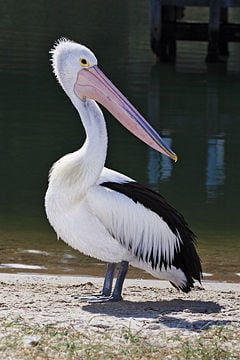 Australian Pelican (Pelecanus conspicillatus).
| ||||||||||||
| Scientific classification | ||||||||||||
| ||||||||||||
|
Pelican is the common name for any of the large aquatic birds comprising the genus Pelecanus of the family Pelecanidae, characterized by heavy bodies, long necks, webbed feet in which all four toes are joined by web, and a long straight bill with a distinctive distenable, featherless pouch used for catching and holding fish prey. There are about eight extant species of pelicans.
Modern pelicans are found on all continents except Antarctica. They occur mostly in warm regions, though breeding ranges reach 45° south (Australian pelican, P. conspicillatus) and 60° North (American white pelicans, P. erythrorhynchos, in western Canada) (Nelson et al. 2003). Birds of inland and coastal waters, they are absent from polar regions, the deep ocean, oceanic islands, and inland South America.
Overview and description
Along with the darters, cormorants, gannets, boobies, frigatebirds, and tropicbirds, pelicans make up the order Pelecaniformes. Members of Pelecaniformes are medium to large aquatic birds with feet in which all four toes are joined by a web (totipalmate) (Howard 2003). The young are born atricial, meaning they have closed eyes and are helpless, requiring they be cared for by an adult. With the exceptio nof the tropicbirds, all lack natal down (Howard 2003). In most pelecaniform birds, there is a distensible gular sac located on the lower mandible, which in pelicans is bare and pendulous (handing down loosely), while in tropicbirds is feathered and in frigatebirds is bar, red, and inflatable (Howard 2003).
Pelicans comprise the Pelecanus genus. Typically, this is considered the only genus within the Pelecanidae family (pelican family) (Myers et al. 2008). However, some taxonomies include the genus Balaeniceps with its sole extant species, the shoebill (Balaeniceps rex) within Pelecanidae (ITIS 1998b). Mayr (2003) also found phylogenetic similarities between the shoebill and the pelicans.
Pelicans are large birds with enormous, pouched bills. The smallest is the Brown Pelican (P. occidentalis), small individuals of which can be as little as 2.75 kg (6 lb), 106 cm (42 in) long and can have a wingspan of as little as 1.83 m (6 ft). The largest is believed to be the Dalmatian Pelican (P. crispus), at up to 15 kg (33 lb), 183 cm (72 in) long, with a maximum wingspan of nearly 3.5 m (11.5 ft). The Australian Pelican has the longest bill of any bird[1].
Pelicans swim well with their short, strong legs and their feet with all four toes webbed (as in all birds placed in the order Pelecaniformes). The tail is short and square, with 20 to 24 feathers. The wings are long and have the unusually large number of 30 to 35 secondary flight feathers. A layer of special fibers deep in the breast muscles can hold the wings rigidly horizontal for gliding and soaring. Thus they can exploit thermals to commute over 150 km (100 miles) to feeding areas.[1]
Pelicans rub the backs of their heads on their preen glands to pick up its oily secretion, which they transfer to their plumage to waterproof it.[1]
Sub-groups
The pelicans can be divided into two groups: those with mostly white adult plumage, which nest on the ground (Australian, Dalmatian, Great White, and American White Pelicans), and those with gray or brown plumage, which nest in trees (Pink-backed, Spot-billed, and Brown, plus the Peruvian Pelican, which nests on sea rocks). The Peruvian Pelican is sometimes considered conspecific with the Brown Pelican.[1]
Feeding
The regular diet of a Pelican usually consists of fish, but they also eat amphibians, crustaceans and on some occasions, smaller birds.[2][3] They often catch fish by expanding the throat pouch. Then they must drain the pouch above the surface before they can swallow. This operation takes up to a minute, during which time other seabirds are particularly likely to steal the fish. Pelicans in their turn sometimes pirate prey from other seabirds.[1]
The white pelicans often fish in groups. They will form a line to chase schools of small fish into shallow water, and then simply scoop them up. Large fish are caught with the bill-tip, then tossed up in the air to be caught and slid into the gullet head first.
The Brown Pelican of North America usually plunge-dives for its prey. Rarely, other species such as the Peruvian Pelican and the Australian Pelican practice this method.
A Pelican in St. James' Park in London was once filmed eating a fully grown Pigeon alive.
Reproduction
Pelicans are gregarious and nest colonially. The ground-nesting (white) species have a complex communal courtship involving a group of males chasing a single female in the air, on land, or in the water while pointing, gaping, and thrusting their bills at each other. They can finish the process in a day. The tree-nesting species have a simpler process in which perched males advertise for females.[1]
In all species copulation begins shortly after pairing and continues for 3 to 10 days before egg-laying. The male brings the nesting material, ground-nesters (which may not build a nest) sometimes in the pouch and tree-nesters crosswise in the bill. The female heaping the material up to form a simple structure.[1]
Both sexes incubate with the eggs on top of or below the feet. They may display when changing shifts. All species lay at least two eggs, and hatching success for undisturbed pairs can be as high as 95 percent, but because of competition between siblings or outright siblicide, usually all but one nestling dies within the first few weeks (or later in the Pink-backed and Spot-billed species). The young are fed copiously. Before or especially after being fed, they may seem to have a seizure that ends in falling unconscious; the reason is not clearly known.[1]
Parents of ground-nesting species have another strange behavior: they sometimes drag older young around roughly by the head before feeding them. The young of these species gather in "pods" or "crèches" of up to 100 birds in which parents recognize and feed only their own offspring. By 6 to 8 weeks they wander around, occasionally swimming, and may practice communal feeding.[1]
Young of all species fledge 10 to 12 weeks after hatching. They may remain with their parents afterwards, but are now seldom or never fed. Overall breeding success is highly inconsistent.[1]
Pairs are monogamous for a single season, but the pair bond extends only to the nesting area; mates are independent away from the nest.
Populations
The Dalmatian Pelican and the Spot-billed Pelican are the rarest species, with the population of the former estimated at between 10,000 and 20,000[4] and that of the latter at 13,000 to 18,000.[5] The most common is believed to be the Australian Pelican (though some estimates have placed the White Pelican at a higher population).
Species
From the fossil record,[6] it is known that pelicans have been around for over 40 million years, the earliest fossil Pelecanus being found in early Miocene deposits in France. Prehistoric genera have been named Protopelicanus and Miopelecanus. The supposed Miocene pelican Liptornis from Argentina is a nomen dubium, being based on hitherto indeterminable fragments.
A number of fossil species are also known from the extant genus Pelecanus:
- Pelecanus alieus (Late Pliocene of Idaho, USA)
- Pelecanus cadimurka
- Pelecanus cauleyi
- Pelecanus gracilis
- Pelecanus halieus
- Pelecanus intermedius
- Pelecanus odessanus
- Pelecanus schreiberi
- Pelecanus sivalensis
- Pelecanus tirarensis
Symbolism and culture
In medieval Europe, the pelican was thought to be particularly attentive to her young, to the point of providing her own blood when no other food was available. As a result, the pelican became a symbol of the Passion of Jesus and of the Eucharist. It also became a symbol in bestiaries for self-sacrifice, and was used in heraldry ("a pelican in her piety" or "a pelican vulning (wounding) herself"). Another version of this is that the pelican used to kill its young and then resurrect them with its blood, this being analogous to the sacrifice of Jesus. Thus the symbol of the Irish Blood Transfusion Service (IBTS) is a pelican, and for most of its existence the headquarters of the service was located at Pelican House in Dublin, Ireland.
For example, the emblems of both Corpus Christi College, Cambridge and Corpus Christi College, Oxford are pelicans, showing its use as a medieval Christian symbol ('Corpus Christi' means 'body of Christ').
Likewise a folktale from India says that a pelican killed her young by rough treatment but was then so contrite that she resurrected them with her own blood.[1]
These legends may have arisen because the pelican used to suffer from a disease that left a red mark on its chest[citation needed]. Alternatively it may be that pelicans look as if they are stabbing themselves as they often press their bill into their chest to fully empty their pouch. Yet other possibilities are that they often rest their bills on their breasts, and that the Dalmatian Pelican has a blood-red pouch in the early breeding season.[1]
The symbol is used today on the Louisiana state flag and Louisiana state seal, as the Brown pelican is the Louisiana state bird. Likewise, the pelican is featured prominently on the seal of Louisiana State University. A pelican logo is also used by the Portuguese bank Montepio Geral.[3]
The Moche people of ancient Peru worshipped nature.[7] They placed emphasis on animals and often depicted pelicans in their art. [8]
ReferencesISBN links support NWE through referral fees
- ↑ 1.00 1.01 1.02 1.03 1.04 1.05 1.06 1.07 1.08 1.09 1.10 1.11 Cite error: Invalid
<ref>tag; no text was provided for refs namedNSS - ↑ "Pelican swallows pigeon in park", BBC News, 25 October 2006. Retrieved 2006-10-25.
- ↑ "Pelican's pigeon meal not so rare", BBC News, 30 October 2006. Retrieved 2007-05-07.
- ↑ BirdLife International 2006. [1]. 2006 IUCN Red List of Threatened Species., World Conservation Union. Retrieved on 11 May 2006.
- ↑ BirdLife International 2004. [2]. 2006 IUCN Red List of Threatened Species., World Conservation Union. Retrieved on 10 May 2006.
- ↑ EvoWiki: Pelecaniformes.
- ↑ Benson, Elizabeth, The Mochica: A Culture of Peru. New York, NY: Praeger Press. 1972
- ↑ Berrin, Katherine & Larco Museum. The Spirit of Ancient Peru:Treasures from the Museo Arqueológico Rafael Larco Herrera. New York: Thames and Hudson, 1997.
- Howard, L. 2003. "Pelecaniformes" (On-line), Animal Diversity Web. Accessed August 19, 2008 at http://animaldiversity.ummz.umich.edu/site/accounts/information/Pelecaniformes.html.
- Integrated Taxonomic Information System (ITIS). 1998a. Pelecanus Linnaeus, 1758 Taxonomic Serial No.: 174683. Retrieved August 19, 2008.
- Integrated Taxonomic Information System (ITIS). 1998b. Pelecanidae Taxonomic Serial No.: 174682. Retrieved August 19, 2008.
Mayr, Gerald (2003): The phylogenetic affinities of the Shoebill (Balaeniceps rex). Journal für Ornithologie 144(2): 157-175.
Myers, P., R. Espinosa, C. S. Parr, T. Jones, G. S. Hammond, and T. A. Dewey. 2008. The Animal Diversity Web (online). Accessed August 19, 2008 at http://animaldiversity.org. http://animaldiversity.ummz.umich.edu/site/accounts/classification/Pelecanidae.html
Gallery
- Pelican sequence.jpg
An Australian Pelican coming out of water
Brown Pelican flock over Havana Bay
External links
- The Symbolism of the Pelican article in the Arlington Catholic Herald.
- Pelican videos on the Internet Bird Collection
Template:Heraldic creatures
Credits
New World Encyclopedia writers and editors rewrote and completed the Wikipedia article in accordance with New World Encyclopedia standards. This article abides by terms of the Creative Commons CC-by-sa 3.0 License (CC-by-sa), which may be used and disseminated with proper attribution. Credit is due under the terms of this license that can reference both the New World Encyclopedia contributors and the selfless volunteer contributors of the Wikimedia Foundation. To cite this article click here for a list of acceptable citing formats.The history of earlier contributions by wikipedians is accessible to researchers here:
The history of this article since it was imported to New World Encyclopedia:
Note: Some restrictions may apply to use of individual images which are separately licensed.
- ↑ Nelson, J. Bryan and Schreiber, Elizabeth Anne; Schreiber, Ralph W. (2003). "Pelicans", in Christopher Perrins (Ed.): Firefly Encyclopedia of Birds. Firefly Books, 78–81. ISBN 1-55297-777-3.
